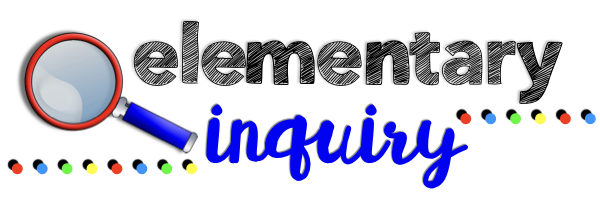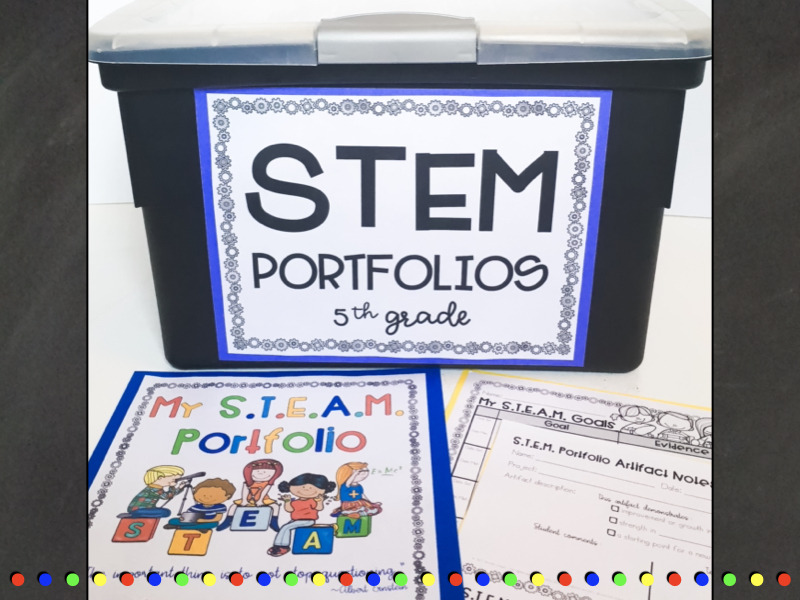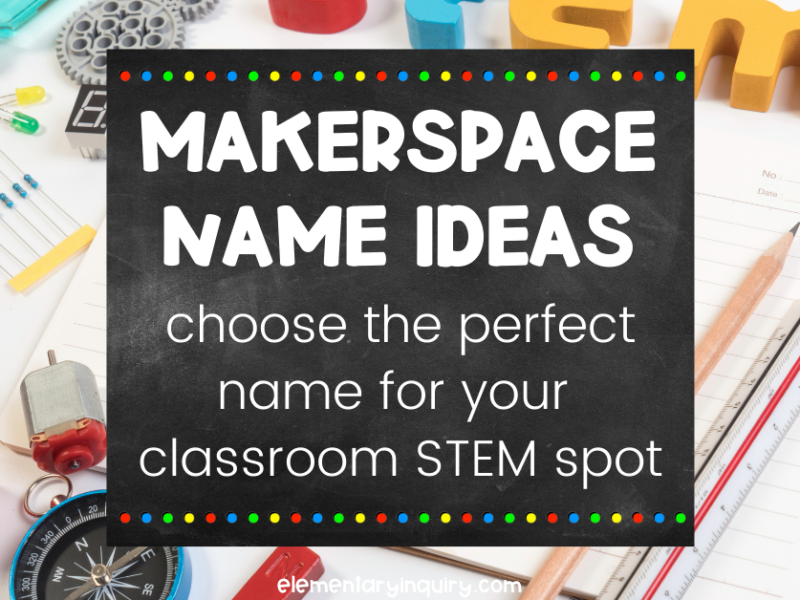You love incorporating STEM projects into your classroom whenever you can fit them in, and your students love STEM challenges so much that it’s like they almost forget they’re learning, too! Maybe you’ve even started to integrate STEM or STEAM into your main content areas of instruction, but it’s difficult to find enough time to do it all. It’s a challenge to evaluate the effectiveness of your STEM program, since STEM skills don’t really fit neatly into report card grades, and they’re certainly not all directly measured on standardized tests.
If that sounds familiar in any way, I hope you’ll consider helping your students curate STEM student portfolios to showcase their work, enhance their learning experiences, and validate the class time you spend doing STEM projects.

Why create STEM student portfolios?
Student portfolios can help teachers, students, parents, and administrators recognize the value of a STEM program, and they can be a tool for identifying areas of challenge and growth beyond the subjects that are traditionally graded. As your students maintain their own portfolios, they’ll continually reflect on their STEM work and set related goals. You’ll empower them to take ownership of their own learning and help them to foster a growth mindset related to STEM content areas and 21st century skills, including collaboration, communication, inquiry thinking, and problem solving. As the teacher, you’ll be able to use evidence and data from students’ STEM portfolios to guide future instructional plans. Their portfolios can also be a powerful communication tool during parent-teacher-student conferences or professional evaluations with your administrator. If you have a school-wide STEM program, students can bring their portfolios from one grade level to the next.
How do I get started with STEM student portfolios?
The beginning of the year is a great time to set up student portfolios, but you can start them anytime you’re ready to begin collecting work samples – or artifacts – from STEM projects.
Each student will need a container for collecting artifacts. You could use binders, folders, plastic drawers, or even new pizza boxes, depending on the kinds of items you’d like to include and how much storage space you have available. I really like using a hanging file box with legal size folders because they allow enough space for larger projects but stay contained and easily accessible. Students can decorate and personalize their portfolios as much or as little as you’d like.
Plan to help students keep a table of contents at the front of their portfolios to log the date and title of each included artifact, along with any other information about why it was chosen for the portfolio.

Start small and be consistent. Include portfolios as part of your regular STEM routine. You’ll quickly build comprehensive portfolios if you ask students to spend just 10 minutes reflecting following each STEM challenge you complete. Students can choose a work sample from the challenge or write a short journal reflection to include in their portfolios. Then, once a month or once a quarter, give students a longer chunk of time to look through portfolios, evaluate their own learning, and set goals for further growth.
Here are several STEM writing and discussion prompts you can share with your students to encourage deeper reflection as they evaluate their own portfolios. Click the image to have a pdf delivered straight to your email.

What is a portfolio artifact?
An artifact is any item chosen to be included in the portfolio. Artifacts might include work samples from a STEM challenge, such as planning pages or finished products; student journal entries or writing samples from STEM projects; students’ reflections, self-evaluations, or other assessment tools you already use; photos or student-created diagrams of work in progress or completed products; or anything else that will fit inside the portfolio.
If your students have online storage, such as Google Drive, you could also include digital components, like photos, videos, and blog posts, in their portfolios. Simply make a note in the portfolio table of contents about where the digital artifact is stored.
What makes a strong artifact?
Artifacts in a portfolio should be thoughtfully chosen so that the curated portfolio provides a picture of student growth and achievement over time. You can teach students to look for three kinds of artifacts:
- Artifacts that showcase a student’s strengths. These are the easiest to find and the ones that students usually most want to include. Including these artifacts can help build self-confidence as students get started with portfolios.
- Artifacts that represent a starting point for a new goal. As students become more comfortable with the process of adding to their portfolios, and as you spend more time modeling constructive reflection, encourage students to include some artifacts that represent an area where they have room for growth. It’s important that you create a classroom culture where mistakes and failures are celebrated as learning opportunities so that students are comfortable thinking critically about their own work.
- Artifacts that demonstrate growth toward or achievement of a goal. This is kind of the whole point, right?!
For each artifact that goes in the portfolio, be sure students include a brief note about why it’s chosen, either on the table of contents or attached directly to the artifact.
How do I take my students’ STEM portfolios to the next level?
Once your students have a few artifacts in their portfolios, you can help them set individual STEM goals. Just like any other academic or social goal we help students set, this requires plenty of discussion and modeling. Left to their own devices, my students usually come up with goals along the lines of, “I want to get a good/better/perfect grade.” If you’re in the habit of incorporating a few minutes of discussion and reflection at the end of most STEM sessions, you’ll be able to guide your students to setting more specific goals based on previous challenges and your classroom expectations. If your students need suggestions for appropriate goals try some of these:
- Consider more than one idea before starting to build.
- Willingly compromise with my teammates when we disagree.
- Try three strategies to resolve a problem before asking for help.
- Use all tools and materials safely.
- Be willing to back up and try something different.
- Look for ways to exceed the challenge criteria.
Goals like these can help foster students’ growth mindset and help them to set a broader purpose for their STEM work. Depending on your class dynamics, you can post goals publicly for shared accountability and encouragement, or students can write their current goal on a sticky note to keep in a notebook as a regular reminder. As students make progress toward their goals, add artifacts to their portfolios to show evidence of growth.
I hope these ideas have encouraged you to set up STEM portfolios with your students this year! I bet you’ll be impressed with your students’ insights and growth, and I hope you’ll be empowered to confidently make instructional decisions about the STEM activities you incorporate into your curriculum as you accumulate evidence from your students’ portfolios. Don’t forget to use them to share your amazing classroom happenings with parents and administrators, too!
You can absolutely start up STEAM portfolios in your classroom with little more than some empty folders and blank notebook paper. If starting that simply feels accessible to you, DO IT! If you’d like a bit more structure from the beginning, or if you’re looking to take your portfolios to a deeper level, please check out this STEAM and STEM Student Portfolios Kit that I’ve compiled. It includes teacher instructions and ready-to-print student resources for all of the aspects I discussed above, along with several versions of student reflections and self-evaluations that can be used with any (or every!) STEAM challenge. It also includes these STEAM portfolio writing prompts… but you can also grab those for FREE now!

Happy teaching!
~Kristin



